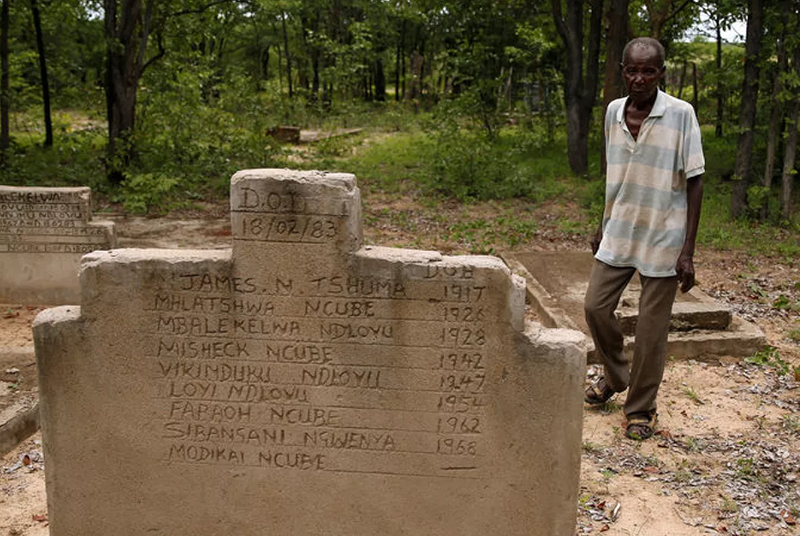- Featured
- No Comment
‘Gukurahundi’ genocide survivors struggle for closure in Zimbabwe

By Agencies
As the 10-year term of the National Peace and Reconciliation Commission (NPRC) in Zimbabwe, aimed at bringing peace and healing to survivors and families affected by past atrocities, approaches its end, a pervasive sense of disillusionment fills those who had placed their hopes in this process.
The commission, established in 2013 under a new constitution, was initially hailed as a beacon of hope, promising truth and closure for the victims and their families but many do not feel it has fulfilled that promise.
“To me, the NPRC is just a circus,” Duncan Maseko, 51, told Minority Africa. His father was among the victims who were abducted 30 years ago. “My only wish is to have full information on the remains of our loved ones.”
Gukurahundi genocide
In the early 1980s, Zimbabwe witnessed a brutal armed conflict stemming from political tensions between ZANU-PF and PF-ZAPU, two former liberation movements, led by Robert Mugabe and Joshua Nkomo, respectively. The government, under then Prime Minister Mugabe, deployed a specialized army unit known as the Fifth Brigadeto the western parts of the country — strongholds of the opposition PF-ZAPU. This resulted in a devastating genocide during the period 1982 to 1987 known as Gukurahundi (a Shona language term broadly meaning “the early rain that washes away the chaff before the spring rains”). Over 20,000 people were killed, and many suffered horrific atrocities, including abduction, torture, and rape.
Maseko’s father, Sam, was a former Zimbabwe People’s Revolutionary Army (ZIPRA), combatant during the armed struggle that resulted in Zimbabwe’s independence in 1980. He was abducted from his home in Bulawayo, the country’s second-largest city, on February 11, 1984, by state security agents and, just like thousands of others, was never seen again by his loved ones.
Most of those so rounded up ended up at Bhalagwe, a Nazi-style detention camp 100 km (100 miles) south of Bulawayo, where they were gruesomely tortured — many of them to their deaths.
By the time a cold peace was established through a lopsided Unity Accord of December 1987, a full-blown genocide had taken place against the Ndebele tribal minority.
The struggle for closure
Since the signing of the Unity Accord, efforts by survivors and families of the victims of the Gukurahundi genocide to get closure have been resisted for more than three decades by successive governments of Zimbabwe.
Former President Robert Mugabe acknowledged the atrocities as a “moment of madness” but resisted calls for a Truth and Reconciliation Commission similar to the one in post-apartheid South Africa. President Emmerson Mnangagwa, accused of involvement in the atrocities, held consultative meetings, but suspicions regarding the government’s commitment persisted, particularly because of attempts to exhume mass graves without full accountability. Some family members and human rights groups accused the government of trying to prevent a more thorough historical accounting of the genocide.
Organisations like Ibhetshu LikaZulu, which had three memorial plaques erected for Gukurahundi victims at Bhalagwe blown up by suspected security agents, vehemently oppose any government involvement in the healing process.
In a statement, the group’s coordinator, Mbuso Fuzwayo said in a statement: “Under no circumstances should there be any government-controlled exhumations and reburials of Gukurahundi genocide victims.”
NPRC: An unfulfilled promise
The NPRC, though initially seen as a ray of hope, struggled throughout its existence because of a lack of resources and political will. Its formation was protracted and contentious, and it has operated for only five out of its intended 10 years. In 2019, Concilia Chinanzvavana, an opposition legislator, applied to the Harare High Court for the extension of the duration of the NPRC to 2028 to recover the five years lost before it was instituted. However, the government appealed to the Supreme Court and got the judgment reversed, as reported by the African Human Rights Yearbook.
The Supreme Court’s decision not to extend the NPRC’s tenure has left survivors disillusioned, asserting that virtually nothing has been achieved in terms of healing and closure for the victims of Gukurahundi and other political brutalities.
The NPRC’s inability to bring closure to Gukurahundi victims reflects a larger issue of lack of political will and acknowledgment of past atrocities in Zimbabwe. Survivors and advocates are calling for international intervention and investigation to address the historical injustices and pave the way for genuine healing and reconciliation. Despite local efforts, the struggle for truth, justice, and reconciliation in Zimbabwe continues, and the wounds of the past remain open for many.
In conclusion, as highlighted in the book “Unspeakable Truths: Transitional Justice and the Challenge of Truth Commissions” by Prof Priscilla Hayner, an expert in transitional justice, no country in the world has ever moved on when injustices of the past have not been genuinely addressed.
